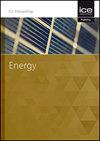Long-term heat storage opportunities of renewable energy for district heating networks
IF 1
4区 工程技术
Q4 ENERGY & FUELS
Proceedings of the Institution of Civil Engineers-Energy
Pub Date : 2023-12-15
DOI:10.1680/jener.23.00023
引用次数: 0
Abstract
This work compares different thermal heat storage solutions existing in the market, fueled with energy from different renewable energy sources with a focus on integrating it into the district heating grid. The paper bases a case on the municipality of Silkeborg, which has the largest solar thermal panel plant in northern Europe. It has been possible to collect data on the produced energy for the municipality of Silkeborg from different renewable energy sources. We used a theoretical approach to compare with assumed excess power from wind and solar in the DK1 area, with Silkeborg's allocated excess power at 0.01%. This yielded overall efficiencies between η = 0.739 - 0.765 and η = 0.864 - 0.895 for the Silkeborg solar thermal plant. These data have been utilized in the analysis, where the journey from harvesting the renewable energy until it reaches the end consumer, comparing the different solutions. Four different thermal heat storage solutions were compared: Tank Thermal Energy Storage, Pit Energy Storage, Aquifer Thermal Energy Storage, and Borehole Energy Storage (BTES). The analysis showed that the best solution for storing thermal energy for a longer period of time was the BTES out of the four solutions compared, with the lowest heat loss rate of 0.6% and the highest efficiency of up to 89.5%. However, some complications make it difficult to establish a BTES storage solution, since it is very much dependent on the earth's conditions and initial capital.区域供热网络可再生能源的长期蓄热机会
这项研究比较了市场上现有的不同蓄热解决方案,这些方案以不同的可再生能源为燃料,重点是将其集成到区域供热电网中。本文以锡尔克堡市为例,该市拥有北欧最大的太阳能热板发电厂。我们收集了锡尔克堡市利用不同可再生能源生产能源的数据。我们采用理论方法,将 DK1 地区风能和太阳能的假定过剩功率与 Silkeborg 分配的 0.01% 过剩功率进行比较。结果显示,锡尔克堡太阳能热电厂的总效率在 η = 0.739 - 0.765 和 η = 0.864 - 0.895 之间。这些数据被用于分析从采集可再生能源到最终用户的整个过程,并对不同的解决方案进行比较。比较了四种不同的热能储存解决方案:储罐蓄热、坑式蓄热、含水层蓄热和钻孔蓄热 (BTES)。分析结果表明,在比较的四种方案中,BTES 是较长时间储存热能的最佳方案,热损失率最低,仅为 0.6%,效率最高,可达 89.5%。然而,由于 BTES 存储方案在很大程度上取决于地球条件和初始资本,因此,一些复杂因素使其难以确定。
本文章由计算机程序翻译,如有差异,请以英文原文为准。
求助全文
约1分钟内获得全文
求助全文
来源期刊

Proceedings of the Institution of Civil Engineers-Energy
ENERGY & FUELS-
CiteScore
3.00
自引率
18.20%
发文量
35
期刊介绍:
Energy addresses the challenges of energy engineering in the 21st century. The journal publishes groundbreaking papers on energy provision by leading figures in industry and academia and provides a unique forum for discussion on everything from underground coal gasification to the practical implications of biofuels. The journal is a key resource for engineers and researchers working to meet the challenges of energy engineering. Topics addressed include: development of sustainable energy policy, energy efficiency in buildings, infrastructure and transport systems, renewable energy sources, operation and decommissioning of projects, and energy conservation.
 求助内容:
求助内容: 应助结果提醒方式:
应助结果提醒方式:


